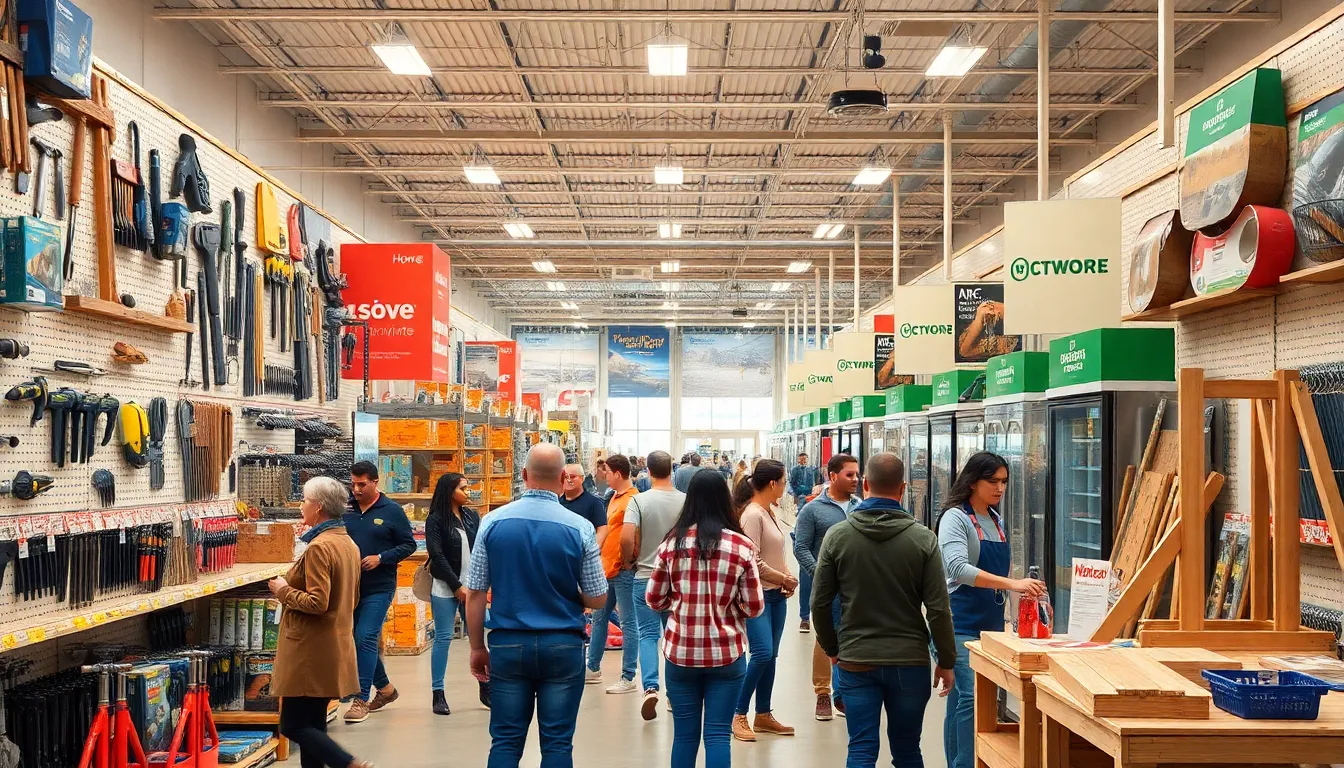When it comes to transforming a house into a dream home, home improvement retailers are the unsung heroes of DIY adventures. Whether it’s a simple paint job or a full-on renovation, these stores are packed with everything needed to turn wild ideas into reality. They’re like treasure chests filled with tools, materials, and inspiration just waiting for the right homeowner to unlock their potential.
Table of Contents
ToggleOverview of Home Improvement Retailers
Home improvement retailers play a significant role in the home renovation market. They provide essential products and services needed for a variety of projects. Tools, materials, and supplies are readily available, catering to both DIY enthusiasts and professional contractors. Retailers like Home Depot and Lowe’s offer extensive selections, which include paint, flooring, and lighting options.
These retailers offer valuable resources, such as workshops and in-store consultations. Many customers benefit from expert advice on best practices for specific projects. Experienced staff members assist with product selection tailored to individual needs. Furthermore, numerous retailers maintain online platforms that facilitate easy browsing and purchasing.
Innovative solutions are increasingly offered through these stores. Smart home devices and energy-efficient materials exemplify how retailers adapt to current trends. Seasonal sales events often provide notable discounts, encouraging homeowners to explore various renovation ideas. By promoting sustainability and efficiency, retailers also contribute to eco-friendly home improvement practices.
Understanding customer preferences is crucial in the competitive market. Retailers frequently gather feedback to refine product offerings and customer service. Engaging with the community through workshops and events fosters loyalty and encourages repeat business. Home improvement retailers remain dedicated to being one-stop shops for homeowners seeking assistance with turning their visions into reality.
Major Players in the Industry

Home improvement retailers play a vital role in providing homeowners with resources and inspiration. Several key players dominate the market, each offering unique products and services tailored to diverse needs.
Home Depot
Home Depot stands as the largest home improvement retailer in the U.S., boasting over 2,200 stores nationwide. This chain provides an extensive inventory of products, including tools, appliances, and building materials. Workshops allow customers to gain hands-on experience in various DIY projects. Seasonal sales events encourage homeowners to take advantage of discounts on popular items. Home Depot’s commitment to innovation includes offering smart home solutions that align with modern consumer trends.
Lowe’s
Lowe’s operates around 1,700 stores across North America, targeting both DIY enthusiasts and professional contractors. With a wide range of home improvement products, Lowe’s emphasizes customer service and expert advice from knowledgeable staff. The retailer frequently hosts workshops that enable individuals to learn new skills. Promotion of eco-friendly products helps align with environmentally conscious shoppers. Regularly updated product offerings ensure customers find the latest trends in home renovations.
Menards
Menards focuses on providing a wide variety of products at competitive prices, with over 300 stores primarily located in the Midwest. It offers home improvement tools, materials, and a selection of outdoor products. The retailer emphasizes price match guarantees to attract savvy shoppers. Menards also features a unique rebate program that incentivizes purchases through discounts. Commitment to customer service ensures that shoppers receive assistance with their projects.
Ace Hardware
Ace Hardware operates as a network of independently owned and operated stores, totaling over 5,000 locations in the U.S. Community-focused, each store tailors its product offerings to local needs. Ace provides a strong selection of tools, paint, and home maintenance supplies with personalized service from knowledgeable staff. Seasonal promotions attract customers looking for timely products. The retailer also emphasizes customer loyalty through its rewards program, fostering long-term relationships with shoppers.
Factors Driving Home Improvement Retailers
Understanding the factors driving home improvement retailers reveals insights into their industry success. These retailers adapt to changing market dynamics and consumer needs.
Market Trends
Growing interest in sustainability influences product offerings among home improvement retailers. Many stores now emphasize energy-efficient materials and appliances that reduce environmental impact. Smart home technology remains popular, with devices like smart thermostats and security systems attracting consumers. Seasonal promotions boost sales during peak times, encouraging homeowners to initiate projects. Data shows that more homeowners prioritize home renovations aimed at increasing property value, impacting sales strategies. Retailers that monitor these trends adapt inventory and marketing tactics accordingly.
Consumer Preferences
Shifting consumer preferences steer the direction of home improvement retailers. Homeowners increasingly favor personalized shopping experiences over generic options. Many consumers seek stores with knowledgeable staff who provide tailored advice and support. Increased online shopping also shapes preferences, prompting retailers to enhance their e-commerce platforms. Product quality becomes a focal point; consumers often choose durable items that ensure long-term satisfaction. Additionally, customer engagement through workshops fosters community ties, driving loyalty and repeat business among homeowners.
Challenges Facing Home Improvement Retailers
Home improvement retailers encounter various challenges that affect their operations and customer satisfaction. Understanding these challenges helps identify areas for growth and improvement.
Supply Chain Issues
Supply chain disruptions significantly impact product availability, leading to longer wait times for customers. Retailers face difficulties in sourcing materials due to global shortages, affecting inventory levels of essential items like lumber and appliances. Delays in shipping result in diminished stock during peak buying seasons. Price surges from suppliers further complicate the situation, prompting retailers to adjust pricing strategies. Proper forecasting and supplier relationships become more critical as they navigate these hurdles effectively.
Competition from E-Commerce
Intense competition from e-commerce platforms poses a threat to traditional home improvement retailers. Shoppers increasingly prefer online purchasing due to convenience and often lower prices. Major players like Amazon provide vast selections and fast shipping options, which appeal to tech-savvy consumers. Physical stores must enhance their online presence and user-friendly interfaces to remain competitive. Offering exclusive online products or services can attract additional customers. Retailers embracing an omnichannel approach can effectively integrate online and in-store shopping experiences, fostering customer retention.
Home improvement retailers play a vital role in the journey of transforming houses into dream homes. They offer not just products but also invaluable expertise and inspiration for every project. As the market evolves these retailers are adapting to consumer preferences by enhancing their offerings and embracing sustainability.
With a focus on customer engagement and innovative solutions they’re positioned to meet the needs of both DIY enthusiasts and professionals. Despite challenges like supply chain issues and competition from e-commerce platforms these retailers continue to thrive. Their commitment to quality service and community involvement ensures they remain essential partners in home improvement endeavors. Homeowners can confidently rely on these retailers to help bring their visions to life.



